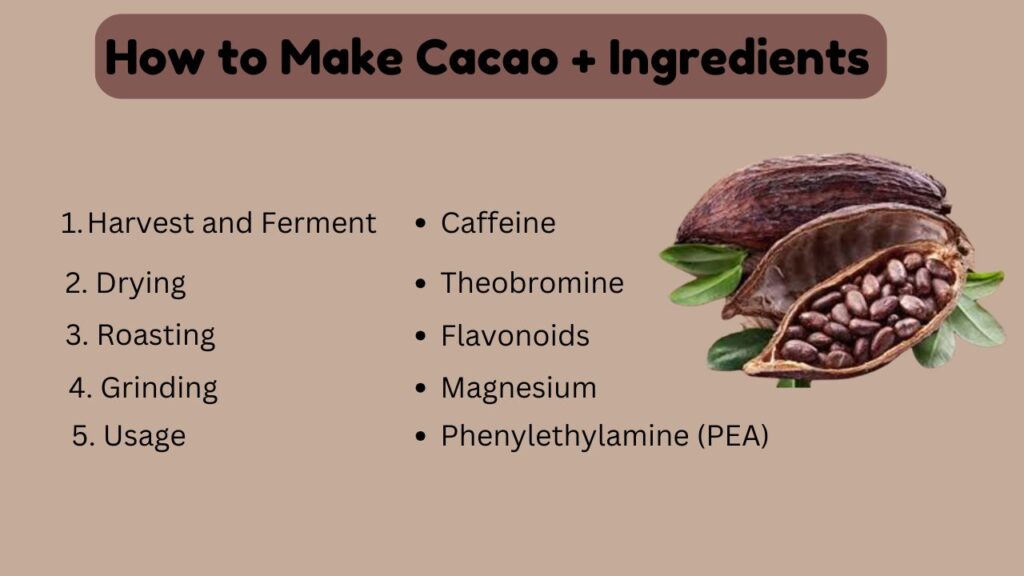Written By: Sherry Harris
Cacao is widely known for its role in making chocolate, but many people wonder whether it contains caffeine. With the rise of health-conscious consumers, understanding the caffeine content in cacao is essential. Caffeine is a stimulant found in various foods and beverages, and its presence in cacao can impact those sensitive to it.
In this article, we will explore whether does cacao have caffeine, compare it with other sources of caffeine, and discuss its benefits and potential side effects.
Table of Contents
What Is Cacao?
Cacao comes from the seeds of the Theobroma cacao tree, which grows in tropical regions. These seeds, often called cacao beans, are harvested, fermented, and dried before being processed into different forms. Cacao can be consumed as raw cacao nibs, cacao powder, or further processed into cocoa powder and chocolate.
Unlike processed chocolate, raw cacao is considered a superfood due to its high antioxidant and nutrient content, making it a popular choice for health-conscious individuals.
Does Cacao Contain Caffeine?
Yes, cacao contains caffeine, but the amount varies depending on the type and processing method. The caffeine content in cacao is relatively low compared to coffee, making it a milder source of stimulation. Raw cacao typically has less caffeine than roasted cacao products like cocoa powder and dark chocolate. Those who are sensitive to caffeine should be aware of these variations before consuming cacao-based products.
Different Forms of Cacao
The amount of caffeine in cacao products depends on how they are processed and consumed. Raw cacao nibs, which are crushed cacao beans, contain around 10-15 mg of caffeine per ounce. Cacao powder has a slightly higher caffeine content, ranging from 12-25 mg per ounce, due to the removal of cocoa butter. Cocoa powder, which is processed at higher temperatures, contains 5-10 mg of caffeine per ounce.
Cacao vs. Other Caffeine Sources
Many people compare cacao to other common sources of caffeine, such as coffee, tea, and energy drinks. While cacao does contain caffeine, it is much lower than the levels found in coffee and some teas. Unlike highly caffeinated beverages, cacao provides a milder and more sustained boost of energy due to its additional compounds like theobromine.
Cacao vs. Coffee
Coffee is one of the most concentrated sources of caffeine, with an average cup containing between 95-200 mg. This is significantly higher than the caffeine content in cacao products. While coffee provides a strong and immediate boost of energy, it can also cause jitters and crashes in some individuals. Cacao, on the other hand, offers a gentler stimulation with additional mood-enhancing benefits due to its theobromine content.
Cacao vs. Tea
Black tea contains approximately 40-70 mg of caffeine per cup, whereas green tea has about 25-50 mg. Cacao generally has less caffeine compared to both, making it a suitable alternative for those looking for a milder stimulant. Theobromine in cacao provides a smoother and longer-lasting energy boost without the sharp rise and fall associated with caffeine in tea or coffee.
Cacao vs. Energy Drinks
Energy drinks are designed to provide a quick and intense caffeine boost, often containing between 80-150 mg per can. They also include artificial ingredients and added sugars, which can lead to energy crashes. Cacao, as a natural source of mild stimulation, provides a healthier alternative for those looking to reduce their intake of artificial stimulants while still maintaining energy levels. Does Cacao Have Caffeine?
Cacao’s Theobromine
Apart from caffeine, cacao contains theobromine, a compound that stimulates the nervous system. Theobromine works similarly to caffeine but has a milder effect, offering a longer-lasting and smoother energy boost.
Unlike caffeine, which affects the central nervous system more directly, theobromine has a more gradual impact, reducing the likelihood of jitteriness. This makes cacao a preferable option for individuals sensitive to caffeine but still looking for a natural way to enhance alertness.
Key Ingredients of Cacao
- Caffeine – A natural stimulant present in cacao, though in lower amounts than coffee. It provides a mild energy boost and enhances alertness without the intensity of coffee.
- Theobromine – A compound that works similarly to caffeine but has a gentler and longer-lasting effect. It contributes to cacao’s stimulating properties while reducing the likelihood of jitters.
- Flavonoids – Powerful antioxidants that help reduce inflammation, support heart health, and protect the body from oxidative stress.
- Magnesium – An essential mineral found in cacao that supports muscle function, brain health, and energy production.
- Phenylethylamine (PEA) – A natural compound that promotes the release of endorphins, enhancing mood and mental clarity.
Nutritional Information of Cacao
Cacao is packed with essential nutrients that provide numerous health benefits. It contains high amounts of antioxidants, fiber, and essential minerals that support overall well-being. The following table outlines the typical nutritional profile of raw cacao powder per 1-ounce (28g) serving:
| Nutrition Facts | Amount per Serving |
|---|---|
| Calories | 120 |
| Total Fat | 3g |
| Carbohydrates | 15g |
| Dietary Fiber | 9g |
| Protein | 5g |
| Magnesium | 90mg |
| Iron | 4mg |
| Caffeine | 12-25mg |
Cacao is particularly valued for its high fiber and magnesium content, which support digestion and muscle function. Its moderate caffeine levels and rich antioxidant profile make it a beneficial addition to a balanced diet.
Do You Know?
👉 How Much Caffeine in Turkish Coffee?
👉 Does Ryze Mushroom Coffee have Caffeine?

Does Cacao Have Caffeine?
How to Make Cacao
Cacao can be prepared in various ways, depending on how it is processed and consumed. Making cacao at home involves a few simple steps that help preserve its natural nutrients while enhancing its flavor.
Step-by-Step:
- Harvest and Ferment – Fresh cacao beans are removed from the pods and allowed to ferment for several days. This process helps develop their rich flavor.
- Drying – The fermented beans are then spread out in the sun to dry, reducing moisture content and making them easier to process.
- Roasting (Optional) – Some cacao beans are roasted to enhance their flavor, although raw cacao retains more nutrients.
- Grinding – The dried or roasted beans are ground into a paste or powder, which can then be used for various recipes.
- Usage – The resulting cacao powder or nibs can be added to smoothies, desserts, hot beverages, or used as a baking ingredient.
Health Benefits of Cacao
Rich in Antioxidants
Cacao is loaded with flavonoids, which are powerful antioxidants that help protect the body from oxidative stress. These compounds play a crucial role in reducing inflammation, improving heart health, and supporting overall well-being. Regular consumption of cacao in its raw or minimally processed form can contribute to better immune function and long-term health benefits.
Boosts Mood
Cacao contains natural compounds like phenylethylamine (PEA) and serotonin, which promote feelings of happiness and mental clarity. These substances help release endorphins, improving mood and reducing stress levels. The presence of theobromine also supports cognitive function by increasing blood flow to the brain, leading to better focus and mental performance.
Supports Heart Health
Flavonoids found in cacao help lower blood pressure, improve circulation, and reduce the risk of cardiovascular disease. By enhancing the flexibility of blood vessels and reducing inflammation, cacao contributes to a healthier heart. Consuming dark chocolate or cacao products in moderation can be a tasty and beneficial addition to a heart-healthy diet.
Enhances Energy Levels
The combination of theobromine and caffeine in cacao provides a natural energy boost. Unlike the rapid spikes and crashes associated with high-caffeine beverages, cacao offers sustained energy throughout the day. This makes it an excellent alternative for individuals who want to stay alert without experiencing the downsides of traditional caffeinated drinks.
Side Effects of Cacao Consumption
While cacao is generally safe, excessive consumption can lead to unwanted side effects. The caffeine and theobromine in cacao can cause an increased heart rate, making it unsuitable for individuals with heart conditions. Consuming large amounts of cacao, particularly in the evening, may disrupt sleep patterns due to its mild stimulant properties.
Additionally, cacao’s natural acidity can contribute to digestive issues such as acid reflux or bloating, particularly when consumed in high doses.
Best Ways to Consume Cacao
Cacao Powder in Smoothies
Adding cacao powder to smoothies is a nutritious way to enjoy its benefits. It blends well with bananas, nut milk, and other superfoods, creating a delicious and energizing drink. This method enhances flavor while providing essential antioxidants and minerals.
Homemade Hot Cacao
Mixing cacao powder with warm milk and a natural sweetener creates a comforting and healthy hot beverage. Unlike processed hot chocolate, homemade hot cacao retains its nutrients and delivers a natural energy boost. This drink is an excellent choice for those seeking warmth and relaxation.
Cacao Nibs as a Snack
Cacao nibs can be consumed on their own or added to yogurt, oatmeal, or salads. They provide a satisfying crunch along with fiber, antioxidants, and essential minerals. Snacking on cacao nibs is a healthy alternative to processed chocolate bars while still enjoying the taste of cacao.
Daily Recommended Intake of Cacao
Moderation is essential when consuming cacao to avoid excessive caffeine or theobromine intake. A daily intake of about 1-2 tablespoons of cacao powder or 1 ounce (28g) of dark chocolate is considered safe for most individuals. This amount provides the health benefits of cacao while minimizing the risk of side effects such as insomnia or digestive discomfort.
For those sensitive to stimulants, consuming cacao earlier in the day is recommended to prevent sleep disturbances. Additionally, balancing cacao consumption with a nutrient-rich diet ensures that its benefits are maximized without negative impacts.
Conclusion
Cacao is a natural source of caffeine, but its levels are relatively low compared to coffee and energy drinks. The presence of theobromine makes cacao a gentler alternative for those looking for a mild energy boost without the intensity of caffeine. Understanding the caffeine content in cacao allows consumers to make informed decisions about their intake.
With its rich antioxidant profile, essential minerals, and mood-enhancing compounds, cacao offers numerous health benefits when consumed in moderation. Whether enjoyed as cacao powder, nibs, or dark chocolate, incorporating cacao into a balanced diet can be a delicious and nutritious choice.
Frequently Asked Question
Q. How much caffeine is in cacao compared to coffee?
Cacao has much less caffeine than coffee, with about 12-25 mg per ounce compared to coffee’s 95-200 mg per cup. It provides a milder energy boost due to theobromine, which acts more gently than caffeine. This makes cacao a great choice for those looking to cut down on caffeine.
Q. Can I consume cacao if I am sensitive to caffeine?
Yes, but in moderation, as cacao contains both caffeine and theobromine. While it’s less likely to cause jitters, some people with caffeine sensitivity may still experience mild stimulation. It’s best to start with a small amount and see how your body reacts.
Q. Does cacao give an energy boost like coffee?
Cacao provides a steady and prolonged energy boost rather than a sudden spike like coffee. This is due to theobromine, which enhances focus and alertness without the jittery effects of caffeine. It’s a great alternative for those who want a smoother energy lift.
Q. Is raw cacao healthier than processed cocoa?
Yes, raw cacao is healthier because it retains more nutrients and antioxidants. Processed cocoa loses some beneficial compounds due to high-heat treatment and may contain additives. Choosing raw cacao ensures you get more natural health benefits.
Q. Can cacao affect sleep?
Cacao may interfere with sleep if consumed in large amounts, especially at night. Its theobromine content can stimulate the nervous system, though it’s gentler than caffeine. To avoid sleep disturbances, it’s best to consume cacao earlier in the day.
Does Cacao Have Caffeine?

